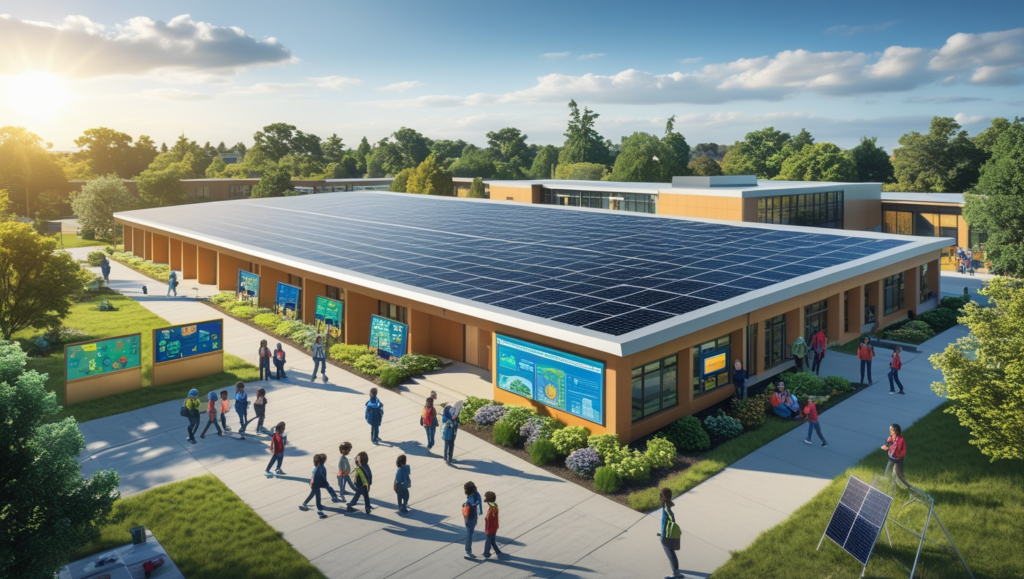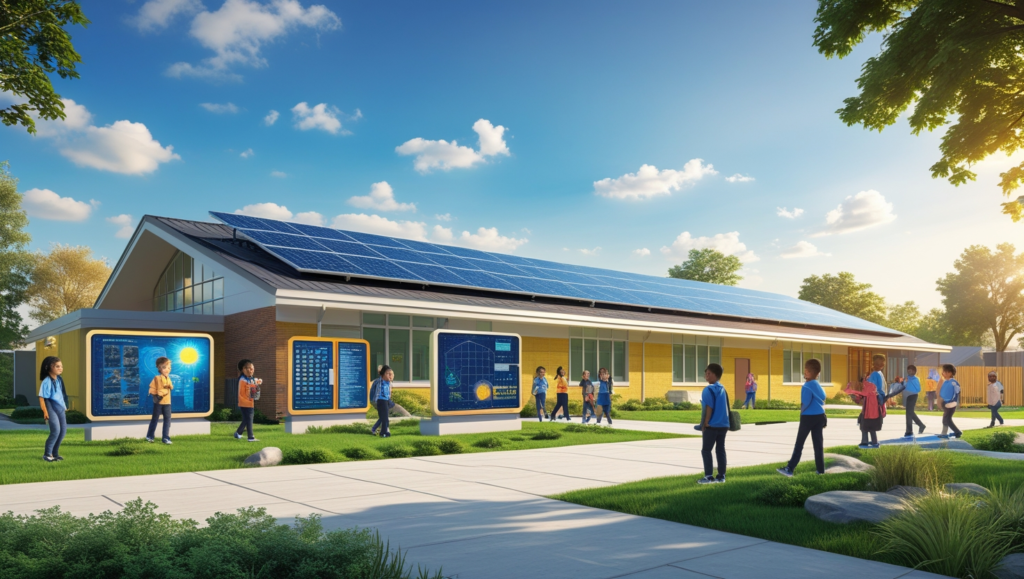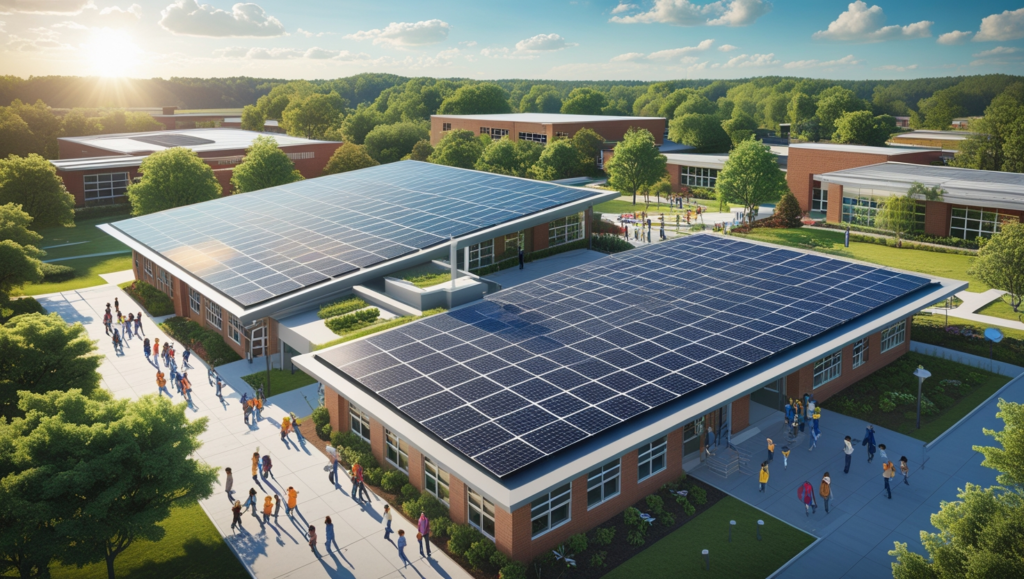In a landmark move for renewable energy adoption, a bilingual elementary school in Florida is set to lead the way with the installation of a 2-megawatt (MW) rooftop solar project. This innovative solar energy initiative will transform the school into an eco-friendly institution, emphasizing the importance of sustainable practices in educational settings.
By integrating a rooftop solar system of this scale, the school not only reduces its reliance on traditional energy sources but also sets an example for renewable energy adoption in schools nationwide. The solar project will also serve as a dynamic educational tool, allowing students to explore the benefits of solar power and gain a deeper understanding of clean energy solutions.
This ambitious project highlights the growing role of solar energy in shaping a greener future, demonstrating the dual benefits of reducing carbon emissions and inspiring the next generation to embrace sustainability.

A Solar Milestone for Schools
The upcoming 2-megawatt (MW) rooftop solar installation marks a significant achievement for renewable energy in education. As one of the largest solar energy systems for schools in Florida, this project is a testament to the growing commitment to sustainability in educational institutions.
Strategically designed to maximize the use of the school’s expansive roof space, the solar array will generate enough clean energy to power a substantial portion of the school’s daily operations. By reducing its reliance on conventional energy sources, the school is taking a pivotal step toward energy independence while also lowering its carbon footprint.
This initiative highlights the potential of solar energy to transform schools into self-sustaining, environmentally responsible spaces, paving the way for similar projects in other educational settings.
Key Benefits of the 2-MW Solar Project
1. Educational Opportunities
The 2-MW rooftop solar project is more than just an energy initiative—it’s a powerful educational tool. Through interactive displays, real-time energy monitoring systems, and solar-focused lesson plans, students will gain hands-on experience with solar energy technology. This integration into the curriculum will provide a deeper understanding of renewable energy and its role in reducing environmental impact. By exploring how solar panels work and their contribution to combating climate change, students will be inspired to become future advocates for sustainability.
2. Environmental Impact
As a source of clean, renewable energy, the solar installation will significantly reduce the school’s carbon footprint. It is estimated to offset thousands of metric tons of carbon dioxide emissions annually, contributing to Florida’s broader goals of reducing greenhouse gas emissions and supporting sustainable practices. By replacing conventional energy sources with solar power, the project underscores the importance of adopting eco-friendly solutions in education and beyond.
3. Cost Savings
The financial advantages of the solar project are equally impressive. Over its operational lifespan, the school is projected to save significantly on electricity costs, providing a sustainable return on investment. These savings can be reinvested into the school to fund educational programs, improve facilities, and support community initiatives. By reducing energy expenses, the school demonstrates how solar energy can drive both environmental and financial benefits.

Community and Government Support
The 2-MW rooftop solar project has received overwhelming support from various stakeholders, reflecting a unified commitment to advancing renewable energy in education. Local government agencies have played a pivotal role by providing guidance and partial funding through state-level renewable energy incentives, aimed at promoting sustainability initiatives in public institutions.
In addition to government backing, the project has attracted support from environmental organizations that recognize the long-term benefits of integrating solar power into schools. These organizations have contributed expertise and advocacy efforts to ensure the success of this initiative.
The surrounding community has also embraced the project, seeing it as a step toward a greener future. Parents, educators, and local businesses have expressed enthusiasm, viewing the solar installation as an opportunity to foster sustainability education and reduce the school’s environmental impact.
Further bolstering the project’s development are private-sector partnerships. Companies committed to advancing green energy in educational settings have provided financial and technical support, ensuring the installation meets the highest standards of efficiency and innovation.
This collaboration between government, community, and private-sector partners highlights the growing recognition of solar energy as a vital solution for creating sustainable and energy-efficient schools.
The Role of Bilingual Education and Sustainability
As a bilingual elementary school, this institution is uniquely equipped to merge the principles of sustainability with a multicultural approach to learning. By leveraging its diverse educational framework, the school will design lessons that emphasize the global importance of renewable energy, ensuring students understand its relevance in different cultural and geographical contexts.
Through tailored curriculum initiatives, students will explore how solar energy and other renewable energy sources are being adopted worldwide to combat climate change and address energy challenges. These lessons will highlight case studies from various regions, empowering students to see the universal value of sustainability and its role in shaping a better future.
The integration of bilingual education with sustainability concepts fosters a unique learning environment where students not only gain knowledge about clean energy solutions but also develop the cultural awareness needed to become global citizens. This innovative approach equips young learners to think critically, act responsibly, and inspire change on an international scale.
By combining the strengths of bilingual education with the principles of environmental stewardship, the school is preparing a generation of environmentally conscious leaders who are ready to make a positive impact both locally and globally.
Challenges and Solutions
Implementing a 2-MW rooftop solar project on a school campus is no small feat and comes with its share of challenges. Key logistical hurdles include conducting comprehensive structural assessments to ensure the building can support the solar array, coordinating installation timelines to minimize disruption to school activities, and integrating the system into the existing energy infrastructure.
To address these challenges, the school has adopted a proactive approach by collaborating with experienced solar energy contractors and structural engineers. Detailed assessments of the school’s roof have been conducted to guarantee its safety and durability for supporting the solar panels. Additionally, a phased installation plan has been developed to ensure minimal impact on daily operations, allowing classes and activities to proceed smoothly.
Another critical component of the project’s success is the involvement of energy consultants. These experts are working closely with the school to integrate the solar system seamlessly into its energy management framework. This includes optimizing energy storage solutions, ensuring compatibility with the school’s electrical grid, and setting up monitoring systems to track performance and efficiency.
Through advanced planning, expert partnerships, and a commitment to overcoming challenges, the school is ensuring the project stays on track while laying the groundwork for a sustainable and efficient energy future.

Looking to the Future
The 2-MW rooftop solar project at this bilingual elementary school is more than just a local initiative—it’s a pioneering example of how schools can integrate renewable energy into their operations, setting a powerful precedent for others across Florida and nationwide.
By combining solar power with educational programs, the school is creating a model for sustainable infrastructure that not only helps reduce carbon footprints but also enhances the learning experience for students. This project showcases how green energy solutions can be applied in schools, creating an environmentally conscious community while providing students with the tools to understand and advocate for a sustainable future.
The success of this solar initiative will inspire other educational institutions to explore similar projects, fostering a broader movement towards sustainability in schools. It serves as a reminder that by investing in renewable energy, schools can reduce their energy costs, minimize environmental impact, and prepare students to be the next generation of green energy advocates.
Looking ahead, this project will likely pave the way for more schools to adopt solar energy solutions, making a lasting impact on the future of education and sustainability.
This project highlights the incredible potential of renewable energy in educational settings. If you’re inspired by this initiative, consider advocating for similar projects in your local schools or supporting organizations that promote green energy. Together, we can pave the way for a brighter, cleaner future.









